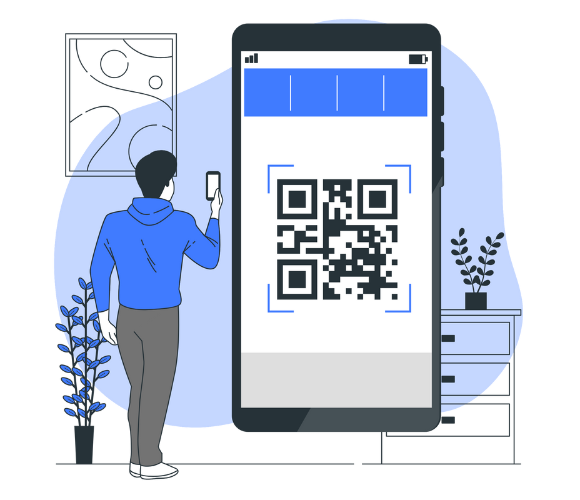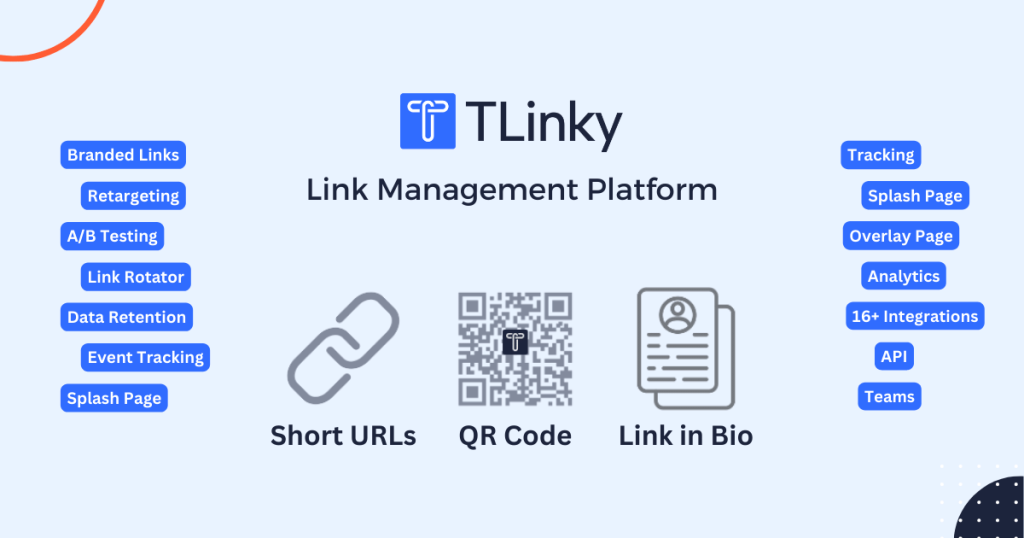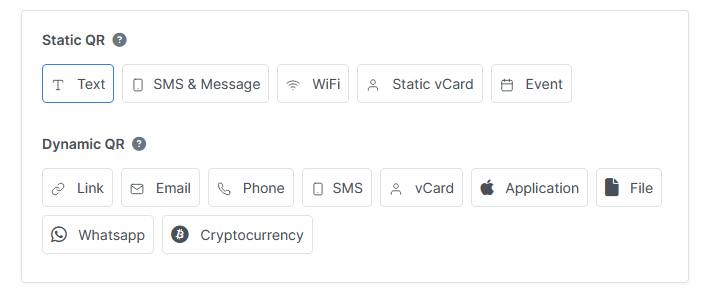Static vs Dynamic QR Code
QR codes have become increasingly popular in recent years, providing a convenient way to share information, access websites, and engage with customers. However, there are two types of QR codes – static and dynamic.
Understanding the difference between Static vs Dynamic QR Code can help you make an informed decision on which one is best suited for your needs.
Unlock the Power of QR Codes! with 14+ different types of QR codes!
Elevate your marketing game with TLinky’s QR Code Generator. Create dynamic, eye-catching QR codes in seconds.
What is a QR code?
A QR code, short for Quick Response code, is a two-dimensional barcode that stores data horizontally and vertically.
Initially developed for tracking automotive parts, QR codes have evolved into versatile tools for various industries.
They encode information such as URLs, text, contact details, or Wi-Fi network credentials.
Users can scan QR codes using smartphones or dedicated QR code scanners, accessing the embedded data quickly and conveniently.
What are QR Code types?
QR codes come in two main types: static and dynamic. Static QR codes contain fixed information and are ideal for scenarios where content remains unchanged over time, like business cards or product labels.
Dynamic QR codes, on the other hand, allow for real-time updates and flexibility, making them suitable for dynamic content distribution and marketing campaigns.
Each type serves different purposes, offering unique advantages based on specific needs and requirements.
What is Static QR Code?
A static QR code is ideal for situations where the information does not need to be modified frequently.

For example, you can use a static QR code to share your contact information, a link to a website, or to promote a specific product or service.
Static codes are easy to generate using a QR code generator, and once created, they can be printed and placed on various marketing materials.
What is Dynamic QR Code?
A dynamic QR code, on the other hand, offers more flexibility and versatility.
With a dynamic code, you can track and analyze user engagement through scanning. You can also edit the content behind the code, whether it’s changing the destination URL or updating product information.
Dynamic QR codes are especially useful for marketing campaigns, event registrations, and inventory management.
Benefits of Dynamic QR Codes
Dynamic QR codes provide several advantages over static codes.
First, they allow for real-time tracking and analysis of user behavior, giving you insights into how effective your QR code marketing campaigns are.
Second, dynamic codes give you the flexibility to revise and update the information behind the code without having to reprint it.
This can save time and resources in the long run. Lastly, dynamic codes offer greater security as they can only be scanned by authorized users, making them more suitable for sensitive information.
What is the difference between static and dynamic QR codes?
Static QR codes are simple, fixed codes that contain information that does not change over time.
These codes are typically created and printed with all the information embedded directly into them.
On the other hand, dynamic QR codes are generated in real-time and allow for the data to be changed or updated at any point.
This means that you can update the content behind the code without having to reprint and redistribute it.

Pros and Cons of Static and Dynamic QR Code
Static QR codes offer simplicity and reliability, ideal for fixed information like business cards and product labels.
They don’t require updates once generated, making them cost-effective. However, they lack flexibility for dynamic content and real-time updates.
Dynamic QR codes provide versatility, allowing for real-time content changes and tracking user engagement.
They offer analytics and the ability to update information without reprinting codes.
Yet, they may require subscription fees and rely on internet connectivity, posing potential reliability concerns.
How to create a static QR code?
To create a static QR code, you can utilize a QR code generator. These online tools like TLinky allow you to input the desired information, such as a website URL or text, and generate a QR code.
Simply enter the content, customize the design if desired, and download the code. Once downloaded, you can print it on various materials like business cards, posters, or product packaging.
Using a QR Code Generator
A QR code generator simplifies the process of creating static codes.
These generators typically offer a user-friendly interface, allowing you to input the desired content and generate the QR code instantly.
Some generators even provide design customization options, allowing you to add branding elements to the code.
Generating a Static QR Code
After using the QR code generator and inputting your desired content, you will receive a downloadable file containing the static QR code.

This file can be saved and printed on various marketing materials, allowing you to reach a wider audience with your message.
Benefits of Using Static QR Codes
Static QR codes offer simplicity and ease of use. They are quick to create and can be printed on various materials, ensuring that your message reaches a wider audience.
Additionally, static codes do not require an internet connection to be scanned, making them suitable for environments with limited connectivity.
How to create a dynamic QR code?
Creating a dynamic QR code follows a similar process to that of creating a static code.
Utilizing a QR code generator, you can input the desired content and generate a code that can be edited or updated at any time.
Using a QR Code Generator
Similar to static QR codes, dynamic codes can be created using online QR code generators.

These generators provide you with the flexibility to add and modify the information behind the code, such as website links, promotional offers, or event details.
Generating a Dynamic QR Code
Once you have inputted the desired information, the generator will produce a dynamic QR code that is ready for use.
The code will include all the data you provided, allowing you to track and modify it as needed.
Use Cases of Dynamic QR Codes
Dynamic QR codes offer a wide range of applications. One common use case is for marketing campaigns, where you can track user engagement, collect data, and measure the success of your campaign.
Another use case is in event registration, where attendees can quickly and easily scan a QR code to register and access event materials.
Additionally, dynamic codes are useful for inventory management, allowing you to track product information and availability in real-time.
When to use static QR codes?
Static QR codes are ideal for fixed information that doesn’t change frequently. They’re best suited for scenarios like business cards, product labels, and signage, where the encoded data remains constant over time.
Use static QR codes for directing users to a website, sharing contact details, or providing general information.
They offer simplicity and reliability, requiring no updates once generated. However, they’re not suitable for dynamic content or situations where information needs regular changes or updates.
Benefits of Using Static QR Codes
Static QR codes are easy to generate and can be printed on various marketing materials, making them a cost-effective solution.
They are suitable for situations where the information does not need to be changed frequently, such as sharing contact details, links to websites, or promoting specific products or services.
Use Cases of Static QR Codes
Static codes can be used in various industries and sectors.
For example, a restaurant can have a static QR code on their menu for customers to access the online ordering system.
Similarly, a retail store can use static codes on product tags, allowing customers to quickly access additional information or make a purchase.
Using Static QR Codes for Marketing and Promotions
Static QR codes are particularly useful for marketing and promotional activities.
They can be placed on print advertisements, billboards, or product packaging to provide customers with easy access to more information about a particular product or service.
Additionally, static QR codes can be used to offer exclusive discounts or promotions, helping to drive customer engagement and sales.
When to use dynamic QR codes?
Dynamic QR codes are advantageous for scenarios requiring flexibility and real-time updates.
They’re ideal for marketing campaigns, event promotions, and inventory management where content changes frequently.
Dynamic QR codes allow for tracking user engagement, altering destination URLs, and updating information without reprinting codes.
Businesses benefit from their versatility in offering personalized experiences and analyzing campaign performance.
Dynamic QR codes are essential for dynamic content distribution, where adaptability and analytics play key roles in optimizing marketing strategies and user interactions.
Benefits of Using Dynamic QR Codes
Dynamic QR codes offer numerous advantages for modern businesses. They enable real-time content updates, allowing for flexible marketing campaigns and promotions.
With dynamic QR codes, businesses can track user engagement and gather valuable analytics to optimize marketing strategies.
They provide the flexibility to change destination URLs and update information without reprinting codes, reducing costs and streamlining processes.
Dynamic QR codes empower businesses to deliver personalized experiences to their audience, enhancing brand engagement and driving conversion rates.
Their adaptability and analytics make them indispensable tools in today’s digital marketing landscape.
Use Cases of Dynamic QR Codes for Inventory Management
Dynamic QR codes can be utilized in inventory management systems to provide real-time tracking and information about products.
Each product can have a unique QR code that, when scanned, provides details about the item, such as stock availability, location, or order status.
This allows for efficient inventory management and reduces the risk of errors or misplacements.
Using Dynamic QR Codes for Event Registration
Dynamic QR codes are commonly used in event registration processes. Attendees can scan the code with their smartphones, allowing for quick and hassle-free registration.
These codes can also link to additional event information or digital tickets, streamlining the event experience for both organizers and participants.
Conclusion
In conclusion, understanding the difference between static and dynamic QR codes is essential when deciding which type to utilize for specific purposes.
Static codes are easy to create and suitable for situations where the information does not change frequently.
On the other hand, dynamic codes offer flexibility, real-time tracking, and the ability to update content as needed.
By considering your specific needs and goals, you can determine which type of QR code is best suited for your requirements.
